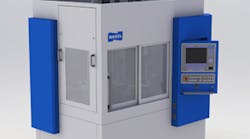Nagel Precision Inc.’s new ECO series 40 and 80 flexible-stroke honing system for low- and medium-volume production reportedly can hold submicron bore sizes and produce mirror finishes. The series is designed with automatic tool-wear compensation and form- error detection and correction capability.
Ann Arbor, Mich.-based Nagel Precision is known as a producer of high-volume honing systems for North American automotive manufacturing. Its new series will be on display later this year at IMTS 2010.
The ECO 40 offers as many as three honing and post-process gauging stations. The ECO 80 may have two honing and in/post process gauging stations. An automatic tool-wear compensation system is integrated into the gauging system. Controlled by AB servos, the system monitors bore size on each part, and tool wear is automatically compensated by fine, submicron-level adjustments that ensure bore accuracy.
Both ECO 40 and 80 represent a significant advance over manual compensation systems, according to Nagel Precision. With a manual compensation system, the operator has to measure the finished bore frequently and manually compensate for tool wear. Over/under compensation is a common problem, reducing control over bore size and promoting excessive machine downtime, as the operator has to stop the machine frequently to compensate for tool wear.
The ECO system’s tool-wear compensation system minimizes non-cutting time while improving bore quality. Once the tool is inserted in the bore, the tool expands at a rapid feed of 200 um/sec and at high torque (45% of available) until it reaches a predetermined position close to the bore. Then, it will switch to a rapid stock-removal mode of about 4 um/sec at lower torques (15% of available torque) to avoid tool damage. Toward the end of the cycle, the expansion rate is reduced to about 2 um/sec, or 10% of the available torque.
The system constantly monitors both the tool feed (u/sec) and the applied torque (as % of available). If the desired feed is not reached at the preset torque, the operator can either reduce the tool expansion rate, if tighter tolerances are desired, or increase the torque, if quicker cycle times are needed.
Tool expansion is rapid when there is no cutting, and is slowest for the final finishing cut, which results in a consistent bore in terms of finish, size, and cylindricality. Where there is form error, for example like taper, hourglass, barrel shape, ovality, bend, etc., both ECO 40 and 80 Honing Systems senses the form error and makes automatic adjustments to correct it.







